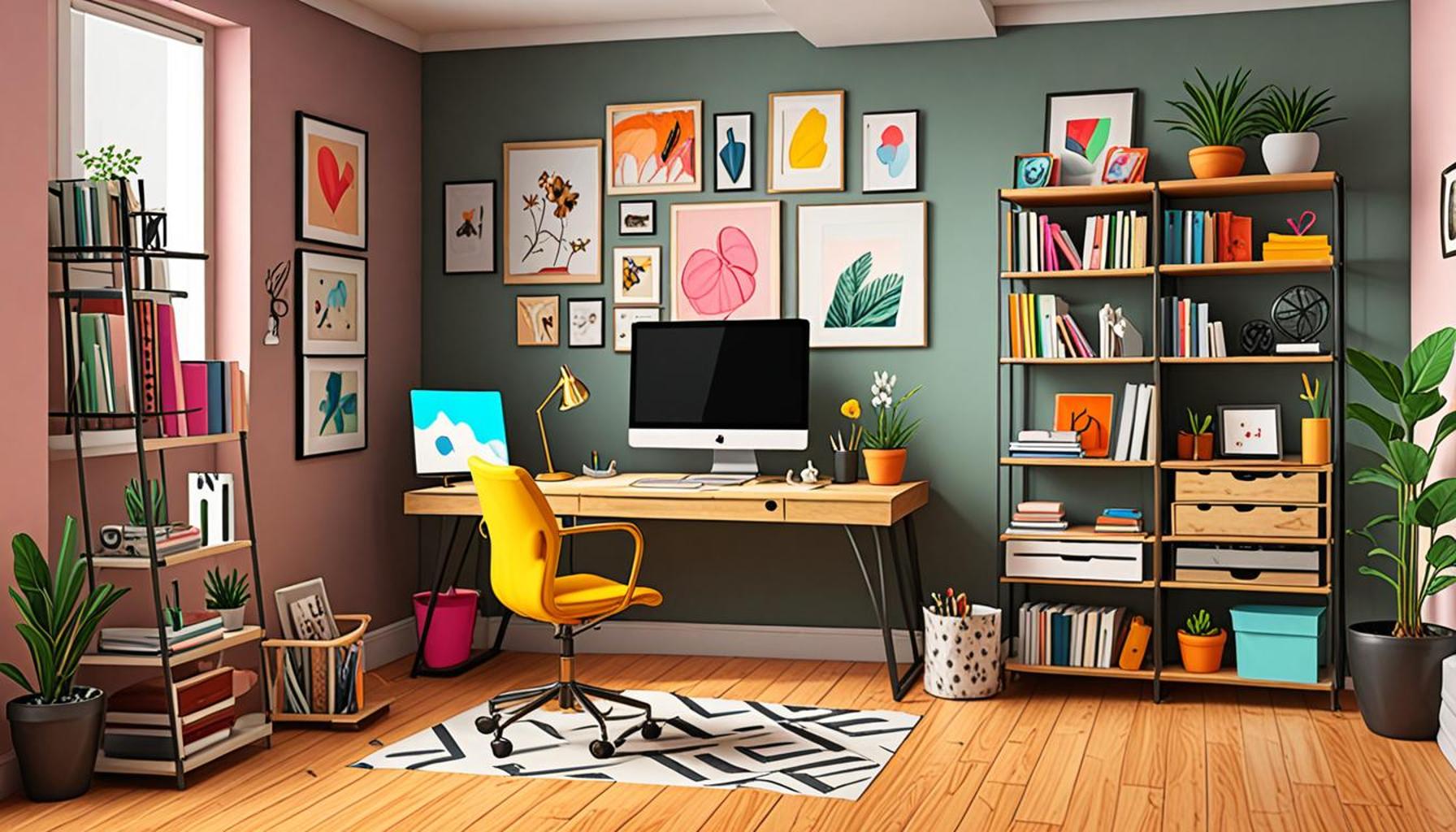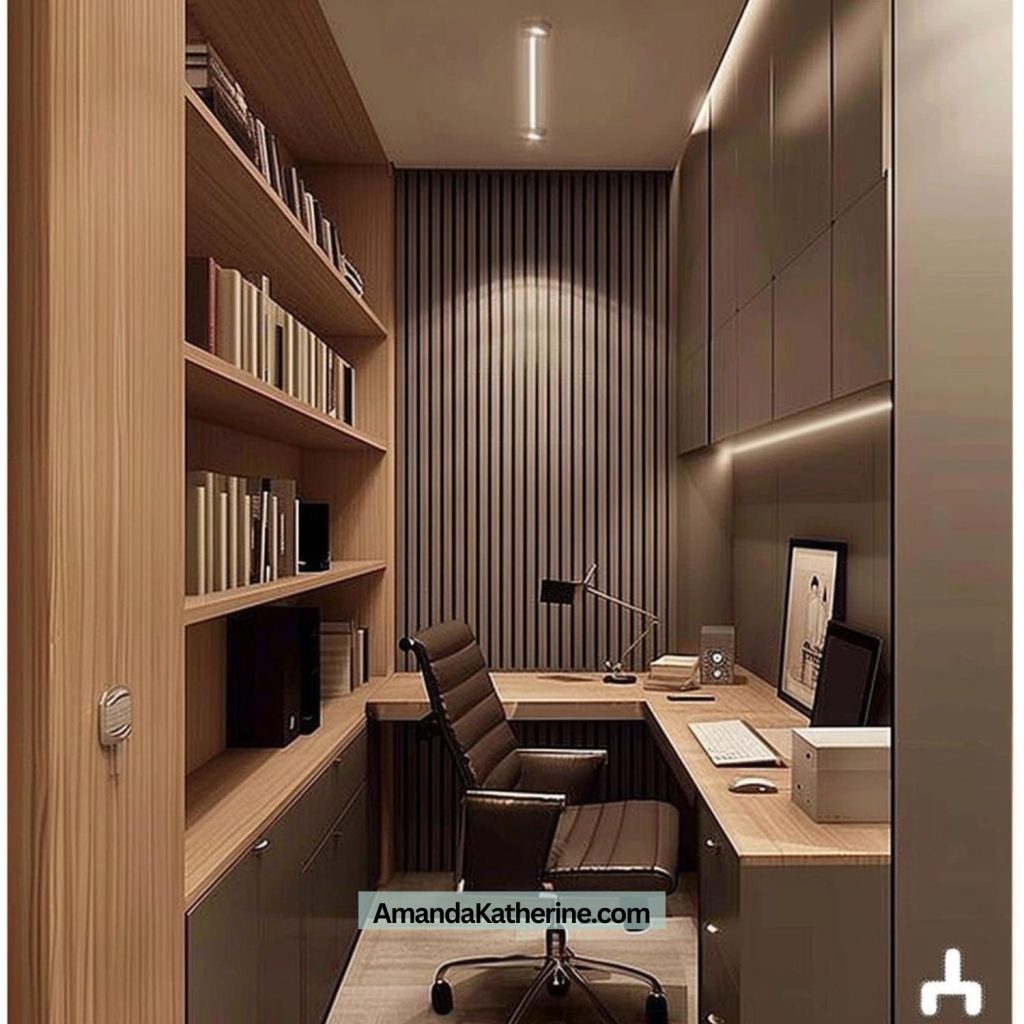Build an Organized Home Office Tips for Efficient Workspace Design

Creating an Efficient Workspace
In an age where remote work has become a steadfast reality for many, the design and functionality of your home office have never been more essential. An organized workspace can lead to significant improvements in productivity, as it minimizes distractions and provides a conducive environment for focus and creativity. This article explores some key elements that will help you construct a more productive home office, as well as tips to maintain its efficiency over time.
Ergonomics Matter
Ergonomics plays a pivotal role in the creation of a sustainable home office. Opting for an ergonomic chair that supports the natural curve of your spine is vital. Look for chairs with adjustable height, lumbar support, and armrests that promote a comfortable seated position. Additionally, the height of your desk should be proportional to your chair; for example, your elbows should form a 90-degree angle when typing. Investing in an adjustable standing desk can also provide flexibility, allowing you to alternate between sitting and standing throughout the day to prevent fatigue.
The Importance of Lighting
Lighting can greatly influence your mood and concentration levels. Adequate lighting is crucial as it helps reduce eye strain and fatigue. Natural light is ideal, so position your desk near a window if possible. If that’s not an option, consider full-spectrum LED bulbs that mimic natural light. Supplementing that with task lights or desk lamps can also enhance visibility for reading and writing. Studies show that well-lit spaces can lead to a boost in productivity and creativity, making it a worthwhile consideration.
Organizational Solutions
Maintaining a clutter-free environment is no small feat, but it is essential for an efficient workspace. Implementing smart organization solutions, such as filing cabinets, shelves, or desktop organizers, can foster productivity. Consider digital organization as well; utilizing apps to manage files and track tasks can reduce paperwork and streamline your workflow. Regular decluttering is crucial; set aside time weekly to remove items that no longer serve a purpose and keep only what you need at hand.
Personal Touches Inspire Creativity
While efficiency is key, infusing your workspace with personal touches can enhance creativity and make your office feel more inviting. Consider adding artwork, personal mementos, or thriving plants that resonate with you. Research shows that natural elements, like indoor plants, can enhance air quality and improve mood, contributing to a more stimulating work environment. Your workspace should be a reflection of your personality, encouraging you to express your creativity and stay motivated.

Actionable Strategies
To maintain an organized and efficient home office, schedule regular assessments of your workspace. Evaluate what’s working and what may need adjustment. Regularly revisiting your setup allows you to make modifications that more closely align with your changing professional goals and personal habits. As you explore these strategies, you’ll find that an optimized workspace not only enhances your productivity but also contributes to a balanced and fulfilling work-life experience.
Transforming your home office into a productive haven takes time and effort, but the rewards in efficiency and job satisfaction are well worth it. Stay tuned for more tips and strategies that can align your goals with the aesthetic and organizational needs of your workspace.
SEE ALSO: Click here to read another article
Maximizing Space and Functionality
When it comes to building an organized home office, maximizing space and functionality is paramount. The layout of your office not only affects your productivity but also your overall work experience. Start by selecting a designated area in your home that can be exclusively for work. It could be a spare bedroom, a corner of your living room, or even a section of your basement. The key is to find a spot that is both quiet and free from distractions.
Consider the flow of movement within your workspace. Arrange your desk and chair in a way that allows you to move freely without bumping into furniture. If your office is small, take advantage of vertical space by incorporating shelves and wall-mounted organizers. This will help keep your desk clutter-free and enable you to utilize every inch of your chosen area efficiently.
Declutter for Clarity
Decluttering is an essential step in creating a welcoming and efficient office environment. A tidy workspace fosters clarity and minimizes distractions. To effectively manage clutter, you can follow these strategies:
- Go Digital: Whenever possible, digitize your documents. Scanning important papers and using cloud storage services can not only save space but also make retrieving files a breeze.
- Daily Clean-Up: Dedicate the last 10-15 minutes of your workday to tidying up your office. This practice ensures that you return to a clean slate the next day.
- Limit Personal Items: While personal touches are important, overcrowding your desk with too many photos or knick-knacks can become distracting. Choose a few meaningful items to keep your space personal without compromising functionality.
Choosing the Right Technology
In today’s digital age, choosing the right technology is crucial for an efficient workspace design. Ensure that your computer, printer, and any other devices you rely on are up-to-date and functioning optimally. Consider investing in a quality monitor with a larger screen size; it can help minimize eye strain and provide more screen real estate for multitasking. Additionally, look into ergonomic accessories such as a keyboard or mouse that support comfortable usage over long periods.
Don’t forget about cable management. Tangles and clutter from cords can quickly transform your sleek workspace into a chaotic mess. Use cable organizers, clips, or even decorative boxes to keep everything in its place. Maintaining a neat technological setup not only enhances aesthetics but also contributes to a more organized work environment.
Color and Decor
The colors and decor in your office can significantly affect your mood and mindset. Opt for colors that inspire productivity and calm, such as soft blue or green hues. Incorporating decorative elements like motivational quotes or functional art pieces can also create a souped-up atmosphere conducive to creativity. Balancing aesthetics with practical decor will make your home office not only a place of work but also a source of inspiration.
By focusing on space optimization, decluttering, technology choices, and decorative elements, you can establish an organized home office that supports your productivity while reflecting your personal style. Remember, creating a workspace that meets your needs is a journey, and regularly reassessing your setup can lead to ongoing improvements.
| Design Elements | Advantages |
|---|---|
| Ergonomic Furniture | Promotes better posture, reducing fatigue and discomfort during long working hours. |
| Decluttered Space | Enhances focus and productivity, allowing for a clearer mind and better performance. |
| Natural Lighting | Improves mood and energy levels, contributing to a more invigorating work environment. |
| Organizational Tools | Facilitates easy access to essential items, enhancing efficiency in daily tasks. |
When designing a workspace, it’s essential to consider how your environment affects your productivity and well-being. The choice of ergonomic furniture can have a transformative impact. Not only does it alleviate body strain, but it also encourages better posture, significantly benefiting long hours spent at a desk. A decluttered space goes hand in hand with focus—eliminating distractions can help you maintain concentration, enhancing your overall performance. Furthermore, the integration of natural lighting into the workspace creates a vibrant atmosphere, improving both mood and energy levels, fostering creativity and motivation.Finally, utilizing organizational tools such as file cabinets, shelves, and digital calendars equips you to access what you need swiftly, improving your efficiency and ensuring a hassle-free workspace. Prioritizing these design elements in your home office can lead to a more organized and productive work experience.
SEE ALSO: Click here to read another article
Creating an Inviting Atmosphere
Beyond functionality, an inviting atmosphere is essential for enhancing your home office experience. The energy of your workspace can significantly dictate your level of comfort and, ultimately, your productivity. To create an ambiance that feels welcoming and conducive to work, consider integrating elements that stimulate your senses.
Natural Light and Lighting Options
Natural light is a powerful motivator. Whenever possible, place your desk near a window to take advantage of sunlight, which can improve mood and focus. If your workspace lacks adequate natural lighting, invest in quality task lighting. A desk lamp with adjustable brightness can help reduce eye strain, especially during late work hours. LED desk lamps with color temperature settings can also mimic daylight, allowing for an improved working environment that promotes alertness.
Additionally, consider accent lighting such as string lights or floor lamps. Warm-colored lights can create a cozy ambiance, making your office a space you look forward to returning to each day.
Ergonomics: Comfort Meets Functionality
Ergonomics play a crucial role in maintaining both comfort and productivity in your home office. A comfortable workspace will directly influence your work habits and overall well-being. Invest in a good office chair that provides lumbar support, as sitting for extended periods can lead to long-term health issues. Look for adjustable chairs that allow you to customize your seating position based on your height and desk setup.
Furthermore, explore options such as a sit-stand desk or a desk converter that can facilitate movement throughout the day. Studies have shown that changing positions can actually combat fatigue and enhance focus. There are even ergonomic footrests that can alleviate pressure on your lower back and legs, further enhancing comfort during those prolonged work sessions.
Personalized Touches
Your workspace should reflect your personality and inspire you on a daily basis. Consider adding elements that resonate with you, such as a vision board, indoor plants, or a motivational calendar. According to various studies, incorporating plants in your workspace can improve air quality and boost your mood. Succulents or low-maintenance species like pothos or snake plants can be ideal for brightening your environment without adding too much responsibility. Personalized touches not only enhance your home office’s aesthetic appeal but also serve as reminders of goals and aspirations, adding a layer of motivation to your daily tasks.
Storage Solutions That Work for You
Finding the right storage solutions is key to maintaining organization within your home office. Take time to assess your storage needs and choose options that complement your workflow. Invest in modular storage systems that are both functional and aesthetically pleasing. For example, open shelving can not only hold books and files but can also display decorative items, blending work and personality.
Drawer organizers and labeled bins can save time searching for necessary supplies and documents. Utilize desk organizers for frequently-used items, keeping your workspace efficient without sacrificing style. A functional filing cabinet can also assist in keeping papers categorized and easily accessible while ensuring your work area doesn’t turn into a paper mountain.
By focusing on creating an inviting atmosphere with adequate lighting, ergonomic solutions, personalized touches, and tailored storage options, you can build a home office that not only enhances productivity but also becomes a space where you genuinely enjoy spending your working hours. As you continue to refine your home office setup, consider how each element contributes to your overall work experience.
CHECK OUT: Click here to explore more
Conclusion: Transforming Your Home Office into a Productive Haven
In conclusion, building an organized home office is not merely about aesthetic appeal; it’s about crafting a workspace designed for efficiency and productivity. By utilizing the right elements such as ergonomic furniture, strategic lighting, and personal decorations, you create an environment that inspires creativity and keeps distractions at bay. Remember that each individual’s needs differ, so it’s essential to adjust your office layout and amenities to fit your unique workflow and personal tastes.
Implementing effective storage solutions is pivotal to maintaining order and enabling quick access to essential materials, thereby minimizing downtime. Consider integrating modular designs or multifunctional furniture to maximize the use of your available space while keeping everything elegantly in reach. The addition of personal touches, from motivational quotes to inviting plants, not only personalizes your work area but also fosters your mental well-being, which is vital for sustained productivity.
As more people transition to remote work, taking the time to cultivate a dedicated home office will significantly impact your efficiency and overall work-life balance. By following these tips, you’re not just organizing a space; you’re enhancing your professional life and unlocking your true productivity potential. Strive to view your home office as a sanctuary optimized for success, and consider reevaluating your setup regularly to ensure it continues to serve you well. Start making small changes today, and watch your workspace transform into a hub of inspiration and motivation.



